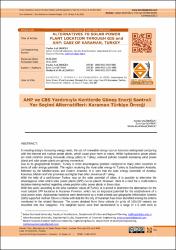Alternatives to solar power plant location through GIS and AHP: Case of Karaman, Turkey
Citation
Salihoğlu, T., Seyrek, E. C., & Kaymakçıoğlu, M. (2020). Alternatives to Solar Power Plant Location Through GIS and AHP: Case of Karaman, Turkey. Kent Akademisi, 13(4), 651-667. https://doi.org/10.35674/kent.746845Abstract
In meeting today's increasing energy needs, the use of renewable energy sources becomes widespread comparing with the thermal and nuclear power plants, which cause great harm to nature. While hydroelectric power plants are most common among renewable energy plants in Turkey, national policies towards increasing wind power plants and solar power plants are gaining momentum. Due to its geographical location, Turkey is more advantageous position compared to many other countries in terms of solar energy potential. The region receiving the most solar energy in Turkey is Southeastern Anatolia, followed by the Mediterranean and Eastern Anatolia. It is seen that the solar energy potentials of Antalya, Karaman, Mersin and Van provinces are higher than other provinces of Turkey. With the help of a well-known Turkey map on the solar potential of cities, it is possible to determine the advantageous cities which solar power plants (SPP) can be placed. However, there is a need for a multi-criteria decision-making method regarding where position solar power plants in these cities.
With this work; according to the solar radiation values of Turkey, it is aimed to determine the alternatives for the most suitable SPP locations in Karaman Province, which has an important potential for the establishment of a solar power plant. Appropriate locations were determined by a multi-criteria and geographic information systems (GIS) supported method. Eleven criteria with data for the city of Karaman have been identified among the criteria mentioned in the related literature. The scores obtained from these criteria (in grids of 100x100 meters) are classified into five categories. The weighted scores were then standardized to a range of 1-5 with tools to reclassify in GIS environment. Reclassified weighted criteria were overlapped with Weighted Overlay Analysis to determine the most suitable regions for SPP investment. kıyasla yenilenebilir enerji kaynakları giderek yaygınlaĢmaktadır. Hidroelektrik santraller Türkiye'deki yenilenebilir enerji santralleri arasında en yaygını olmakla birlikte, rüzgar santralleri ve güneĢ enerjisi santrallerinin artırılmasına yönelik ulusal politikaların da ivme kazandığı görülmektedir. Coğrafi konumu nedeniyle Türkiye, güneĢ enerjisi potansiyeli açısından diğer birçok ülkeye göre daha avantajlı bir konuma sahiptir. Türkiye'de en fazla güneĢ enerjisi alan bölge Güneydoğu Anadolu, ardından Akdeniz ve Doğu Anadolu'dur. Antalya, Karaman, Mersin ve Van illerinin güneĢ enerjisi potansiyellerinin Türkiye'nin diğer illerinden daha yüksek olduğu görülmektedir. ġehirlerin güneĢ enerjisi potansiyeline iliĢkin Türkiye haritası yardımıyla, güneĢ enerjisi santrallerinin (GES) yer seçimi açısından avantajlı Ģehirleri belirlemek mümkündür. Bununla birlikte, bir Ģehir içerisinde güneĢ enerjisi santrallerinin nerede konumlandırılabileceğine iliĢkin çok kriterli karar verme yöntemine ihtiyaç vardır. Bu çalıĢma ile; ülkemizin güneĢ radyasyonu değerlerine göre bir güneĢ enerjisi santrali kurulması için önemli bir potansiyele sahip olan Karaman ilindeki en uygun GES yerlerine iliĢkin alternatiflerin belirlenmesi hedeflenmektedir. Uygun yerler çok kriterli ve coğrafi bilgi sistemleri destekli yöntemle belirlenmiĢtir. Ġlgili literatürde bahsedilen kriterler arasında Karaman kenti için elde edilebilen verilere bağlı olarak on bir kriter belirlenmiĢtir. Bu kriterlerden elde edilen puanlar düĢükten yükseğe doğru beĢ kategoride sınıflandırılmıĢ, yeniden sınıflandırılan ağırlıklandırılmıĢ kriterlere Ağırlıklı Bindirme Analizi uygulanarak GES yatırımı için en uygun bölgeler belirlenmiĢtir.
Source
Kent AkademisiVolume
13Issue
4Collections
- Makaleler [10]



















